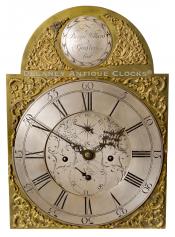Benjamin Willard tall clock. Grafton, Massachusetts. Circa 1772. XXSL-58.
This is a fine Chippendale cherry case tall clock featuring a composite brass dial. It is signed by the clockmaker "Benja. Willard / Grafton / fecit."
This is an early example. The case is constructed in cherry and features a rich, darker finish. The case is supported by double-stepped molding. The lower molding forms feet and these are raised on pads. The base is somewhat compressed. This is a common design detail for clock cases manufactured in the Colonies during this early period. The waist section is long and centers a large-shaped waist door. This door is trimmed along its perimeter with a molded edge. This door opens to access the pendulum and two drive weights. The hood or bonnet features a full pagoda top. The outer corners of the hood are fitted with finial plinths that support brass ball-and-spiked finials. Fully turned bonnet columns flank the dial door and are mounted in brass capitals. The back quarter columns are shaped and neatly fitted into the corners of the hood, which also features tombstone-shaped side lights. The bonnet door is also in an arched form and fitted with glass. This door opens to access the dial.
This style of dial predates the painted dial form. It is composed of a brass sheet and is decorated with a number of decorative elements. Four cast corner spandrels frame the applied time ring. There are two additional spandrels in the arch. These center a the Clockmaker's name boss, which reads, "Benja. Willard / Grafton / fecit." The time or chapter ring features Arabic-style five-minute markers, a closed minute ring, and large Roman-style hour numerals. Inside this ring, the dial surface has been decoratively engraved. Here one will also find a display for the calendar day and an inset subsidiary seconds dial. The hands are wonderfully hand filed.
The two-train movement is brass, eight-day duration, and is of good quality. Four-turned pillars or posts support the two large brass plates. Hardened steel shafts support the polished steel pinions and brass gearing. The winding drums are grooved. The escapement is designed in a recoil format. The movement is weight driven and designed to run for eight days on a full wind. It features a having a rack and snail striking system. As a result, it will strike each hour on a cast iron bell mounted above the movement.
This clock stands approximately 83 inches or 7 feet 7.5 inches tall to the top of the center finial. The upper bonnet molding is approximately 21.5 inches across and 10.5 inches deep.
This clock was made circa 1772.
Inventory number XXSL-58.












